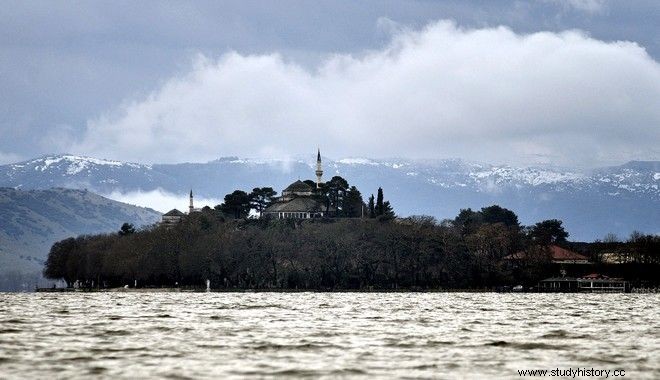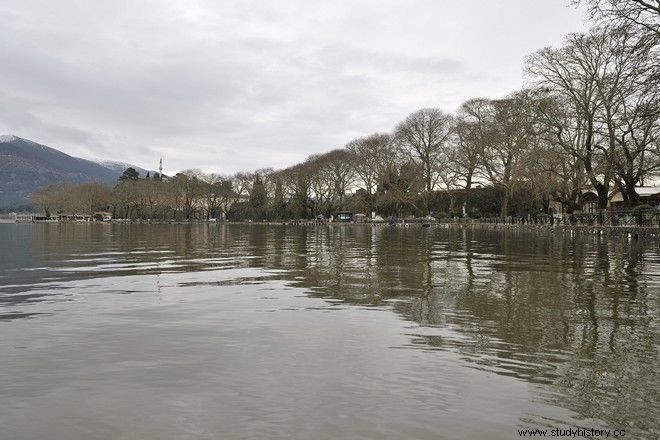On the island of Ioannina, in Lake Pamvotida, the former president of the Republic, Karolos Papoulias, will be buried on Thursday.
The small island, the only one without a name, is inhabited by just over 200 inhabitants, while it is one of the two inhabited islands in a lake in Greece.

The island is located in the northwestern part of the lake, has an area of 200 acres and a maximum altitude of 520 meters above sea level or 59 meters above the surface of the lake.
The settlement is located at the northern end of the island and consists of approximately 110 houses. The popular tourist destination is an officially declared traditional settlement, as it is built reverently following traditional Epirus architecture with its characteristic slate roofs.

Inseparably connected to the city, the island is connected daily by frequent ferry routes, which makes access quite easy for any traveller. Below you can read 5 things you should know about the Isle of Ioannina.
1) The great History
The first historical references to the Island of Ioannina begin in the 13th century, when the first monasteries were founded. The first monastery to be founded was the Monastery of Agios Nikolaos of Philanthropines which was inaugurated in the 13th century and its catholicon was built in 1292 as stated in an inscription at the entrance of the church. The founder of the monastery is Michael Philanthropinos, who had also served as metropolitan of Ioannina.
Around the same period, the Monastery of Agios Nikolaos Dilios was founded by the Byzantine Stratigopoulos family. In the 16th century, the monastic community on the island flourished, resulting in the founding of two more monasteries. The Monastery of Agios Nikolaos Methodios which was later renamed Agia Eleusa and the Monastery of Prodromou, while in the following century three other monasteries were founded. The Monastery of Agios Panteleimon, the Monastery of the Transfiguration of the Savior and the Monastery of Prophet Ilias built on the top of the island.
2) The story of Kyra Frosyn
The heart-wrenching story is that of Mrs. Frasony, it is nothing less than a love story between the independent and defiant, for the time, spirit of Mrs. Frasynth and Ali Pasha's married son, Mukhtar. Ali Pasha, pressured by his son's family and wife, arrests Kyra Frosini along with 17 other women and sentences them to drowning in Lake Pamvotida.
Ali Pasha decided to execute her along with 17 other local women by drowning in the lake of Ioannina, on the official grounds that they were living immorally, something about which doubts have been expressed and Ephrosyne Vassiliou was even considered a victim of political persecution.
Fate did not reserve better luck for Ali Pasha, since 20 years later, after a conflict he had with the Sultan of the City, he was beheaded on the island of the lake.
3) The unique island without a name
The island has a world first, since it does not have a name. They call it "island of the lake" or "island of Ioannina". A walk to Nisaki, regardless of the season, will please every traveler.
A stop for a coffee or a tea in a traditional cafe, overlooking the lake, is all you need to get out of the city routine, enjoying nature and the 26,000-year-old lake. The walk through the alleys that are formed between the traditional stone houses of Epirus construction is unique.
4) The local flavors
The Island of Ioannina is one of the few places in the world where one can enjoy frog legs, fresh eel, and fresh trout.
Travelers from all over Greece, as well as abroad, choose this destination, with the aim of eating well, but also a lot, since the portions in Ioannina are large and delicious.
5) When William Martin Leake was enchanted by the Isle
The British soldier, diplomat, traveler and writer William Martin Leake visited Ioannina at the beginning of the 19th century, was enchanted by Nissaki and wanted to write his impressions about it.
"The Island extends over an area 1 mile long and 1/3 of a mile wide. On it there is a residence of the Vizier, five small monasteries and a village of 100 houses. The fishermen of the Island secured a monopoly of the fishery, paying Ali 15,000 piastres a year. They were still obliged to pay the customary tribute and to supply the Serai with firewood.
The village is located among gardens and plane trees. The cleanliness of the houses is nowhere to be found among the lower class of Ioannina and the villages of the area. An exception is the Vlachs of Pindos. The women spin cotton and bleach the cloths that are woven in Ioannina. The monasteries are now used for prisons, in which prisoners from all parts of the Vizier's Territory are gathered" , the great traveler had written among others.
Follow News247.gr on Google News and be the first to know all the news
